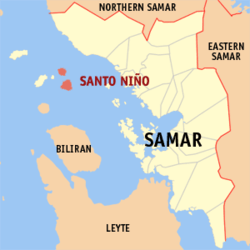Santo Niño, Samar
| Santo Niño Limbancauayan | |
|---|---|
| Municipality | |
 Map of Samar with Santo Niño highlighted | |
.svg.png) Santo Niño Location within the Philippines | |
| Coordinates: 11°56′20″N 124°25′10″E / 11.93889°N 124.41944°ECoordinates: 11°56′20″N 124°25′10″E / 11.93889°N 124.41944°E | |
| Country | Philippines |
| Region | Eastern Visayas (Region VIII) |
| Province | Samar |
| District | 1st district of Samar |
| Barangays | 13 |
| Government[1] | |
| • Mayor | Lilia A. Coñejos |
| Area[2] | |
| • Total | 29.53 km2 (11.40 sq mi) |
| Highest elevation | 470 m (1,540 ft) |
| Lowest elevation | 429 m (1,407 ft) |
| Population (2015 census)[3] | |
| • Total | 12,863 |
| • Density | 440/km2 (1,100/sq mi) |
| Time zone | PST (UTC+8) |
| ZIP code | 6712 |
| IDD : area code | +63 (0)55 |
| Income class | 5th municipal income class |
| PSGC | 086018000 |
| Electorate | 9,791 voters as of 2016 |
Santo Niño is a 5th class municipality in the province of Samar, Philippines. According to the 2015 census, it has a population of 12,863 people.[3]
The town consists of the northern island of Camandag and the larger Santo Niño Island about 3.1 kilometers (1.9 mi) to the south. In between those two islands is the smaller Pilar Island.[4] The municipality's poblacion (town center) is located in Santo Niño Island.
Geography
The islands are located in Samar Sea about 24 kilometers (15 mi) south-west of Calbayog City in the main island of Samar.
Santo Niño Island
The larger Santo Niño Island is about 18 kilometers (11 mi) north-west of Maripipi, Biliran province with an area of about 19.4 square kilometers (7.5 sq mi). Both islands are volcanic in origin with Santo Niño having the highest elevation in the municipality at 470 meters (1,540 ft).[5] [6]
Camandag Island
The circular Camandag Island is located north of Santo Niño Island, about 3.1 kilometers (1.9 mi) shore to shore. It has area of about 9.8 square kilometers (3.8 sq mi) with an elevation of 429 meters (1,407 ft).[5][7]
Pilar Island
The smallest island of the municipality is located 2.3 kilometers (1.4 mi) off north-west of Santo Niño Island and about 3.5 kilometers (2.2 mi) south-west of Camandag Island. Pilar Island has an elevation of 145 feet (44 m).[8]
Political subdivision
Santo Niño is politically subdivided into 13 barangays.
Camandag Island
- Balatguti
- Corocawayan
- Lobelobe
- Pinanangnan (JMBere Coco+Cacao Farms)
- Sevilla
- Villahermosa
Santa
- Baras
- Basud (Pob.)
- Buenavista
- Cabunga-an
- Ilijan
- Ilo (Pob.)
- Takut
Town History
This town has an ancient Bisayan name Limbankawayan which derived from the word limba meaning red and kawayan means bamboo thus a red colored bamboo (phyllostachys iridescens) which is abundant during those days.
It was separated from Calbayog and made a pueblo and a parish by a Royal Decree of September 29, 1898. The Bishop of Cebu had recommended in 1895 that it achieve parish status, though final approval and confirmation was not relayed from Madrid through Manila until the year 1897.
Demographics
| Population census of Santo Niño | ||
|---|---|---|
| Year | Pop. | ±% p.a. |
| 1903 | 3,372 | — |
| 1918 | 3,833 | +0.86% |
| 1939 | 4,926 | +1.20% |
| 1948 | 6,003 | +2.22% |
| 1960 | 8,304 | +2.74% |
| 1970 | 9,086 | +0.90% |
| 1975 | 11,124 | +4.14% |
| 1980 | 11,132 | +0.01% |
| 1990 | 11,743 | +0.54% |
| 1995 | 12,761 | +1.57% |
| 2000 | 12,545 | −0.37% |
| 2007 | 12,777 | +0.25% |
| 2010 | 13,504 | +2.03% |
| 2015 | 12,863 | −0.92% |
| Source: Philippine Statistics Authority [3][9][10][11] | ||
Accessibility
There are no airports on the islands of Santo Niño and Camandag. The islands are reached by boats from the Port of Calbayog City.[6]
See also
References
- ↑ "Municipalities". Quezon City, Philippines: Department of the Interior and Local Government. Retrieved 14 May 2013.
- ↑ "Province: Samar (Western Samar)". PSGC Interactive. Makati City, Philippines: National Statistical Coordination Board. Retrieved 14 May 2013.
- 1 2 3 Census of Population (2015). "Region VIII (Eastern Visayas)". Total Population by Province, City, Municipality and Barangay. PSA. Retrieved 20 June 2016.
- ↑ "Pilar Island, Santo Niño, Philippines". Google Maps. Retrieved on 2013-11-10.
- 1 2 U.S. Army Corps of Engineer (1954). "Bogo (topographical map)". University of Austin Library. Retrieved on 2013-11-11.
- 1 2 Fabian, Galwin (2013-09-21). "Santo Niño Island in Samar". Intrepid Wanderer. Retrieved on 2013-11-11.
- ↑ Fabian, Galwin (2013-09-19). "Camandag Island in Samar". Intrepid Wanderer. Retrieved on 2013-11-11.
- ↑ U.S. Coast and Geodetic Survey (1919). "United States Coast Pilot, Philippine Islands, Part 1", pg. 205. Government Printing Office, Washington.
- ↑ Census of Population and Housing (2010). "Region VIII (Eastern Visayas)". Total Population by Province, City, Municipality and Barangay. NSO. Retrieved 29 June 2016.
- ↑ Census of Population (1995, 2000 and 2007). "Region VIII (Eastern Visayas)". Total Population by Province, City and Municipality. NSO. Archived from the original on 24 June 2011.
- ↑ "Province of Samar (Western Samar)". Municipality Population Data. Local Water Utilities Administration Research Division. Retrieved 17 December 2016.
External links
- Philippine Standard Geographic Code
- Philippine Census Information
- Local Governance Performance Management System
